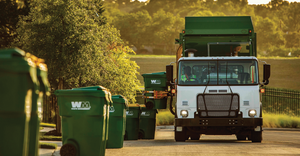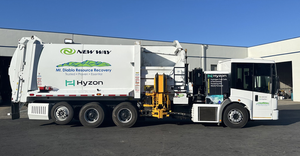How Jeans Redesign Guidelines Will Propagate Circularity in the Fashion Industry

What does a circular economy look like for the fashion industry?
The Ellen MacArthur Foundation is working on changing the industry’s very shape through its Make Fashion Circular initiative, which aims to “stimulate the level of collaboration and innovation necessary to create a new textiles economy,” according to the organization’s mission.
Originally launched as the Circular Fibres Initiative in May 2017, Make Fashion Circular brings together leaders from some of the most recognizable names in the industry including Burberry, Gap Inc., H&M Group, HSBC, Inditex, PVH and Stella McCartney.
The rapid rise of fast, throwaway fashion has prompted a call for action for designers, manufacturers and industry stakeholders to work collectively to change the design process with sustainability in mind.
This includes jeans, the target of Make Fashion Circular’s newest set of guidelines, aptly named the Jeans Redesign Guidelines. The goal? If these fashion giants jointly use this design standard and implement it at scale, it will eliminate the waste and pollution generated at the first thread of the supply chain.
Laura Balmond, Make Fashion Circular program manager, and Waste360 recently discussed the issues that led to creation of the initiative, the process of developing the guidelines and the durability of denim under the new guidelines.
Waste360: Why were these guidelines developed? For those who might not be aware, please describe the waste generated from fashion.
Balmond: The fashion industry doubled its production of clothing between 2000 and 2015, yet, over the same period, the amount of time clothing is worn before it is thrown away fell by around 40%. When it is thrown away, 73% of clothing is burned or sent to landfill. Only around 12% is collected for recycling, and the majority of that ends up being shredded and used to make things like mattress stuffing, insulation or cleaning cloths. Less than 1% of what is collected is used to make new clothes. On top of this, the production methods used to make our clothing cause considerable amounts of pollution. For example, industrial cotton production uses large amounts of synthetic pesticides and fertilizers, and the dyeing processes often use chemicals that are harmful to the environment or garment workers.
Jeans are no different. As we have seen with the rest of the fashion industry, the way we produce and sell jeans is leading to huge problems with waste and pollution.
In a circular economy for fashion, clothes are used more, are made to be made again, and are made from safe and renewable materials. Through our work in Make Fashion Circular, we learned that many organizations had the challenge to break this down into clear actions that would see all three principles applied at the same time. By starting with jeans, the Jeans Redesign aims to provide a framework for the industry to design clothing for a circular economy. The guidelines set out minimum requirements on garment durability, material health, recyclability and traceability. If participants collectively adopt the guidelines, at scale, and in all four areas at the same time, there is an important opportunity to collectively raise the ambition level of the fashion industry.
Waste360: When were these guidelines initially developed? How long did it take to revise them?
Balmond: The Jeans Redesign builds on the extensive research from the report “A New Textiles Economy: Redesigning Fashion’s Future”. Make Fashion Circular conducted further research involving denim experts from multiple brands, manufacturers, recyclers and academia to create draft guidelines. These were tested with further experts to ensure they would be an ambitious step forwards for the denim industry. The guidelines were launched in July 2019, with 16 organizations signed-up to produce jeans in line with the principles of a circular economy by May 2021. The guidelines were extended to include criteria for fabric manufacturers at the end of 2019, and there are now almost 70 participants taking part.
The project is a starting point and offers participants an opportunity to learn how to apply circular design more widely within their organization. The initial conversations highlighted concerns from participants around changing longstanding design features, such as removing rivets or limiting the amount of stretch. Early outcomes have shown that many brands have embraced these changes and even expanded their initial designs to include other denim products, such as jackets and hats.
Waste360: How much longer will these new jeans last?
Balmond: The Jeans Redesign Guidelines set out minimum requirements on garment durability, material health, recyclability and traceability. Make Fashion Circular conducted research involving multiple brands, manufacturers and recyclers which revealed that there are currently no consistently used methods or baselines across the fashion industry for measuring and comparing the durability of garments. Various performance indicators – such as tensile strength, abrasion resistance and colour fastness – are used at a company level, but there is no common measure. Therefore, the guidelines offer a starting point for the industry to move towards alignment on durability. Jeans should withstand a minimum of 30 home laundries, while still meeting the minimum quality requirements of the brands.
In addition, the way clothes are produced, including the way fabric is made and chosen, rarely considers the recyclability of the materials once they are no longer used. Converging towards an optimized palette of materials – including blends where these are needed for functionality – and developing these alongside highly efficient recycling processes for those materials, is a crucial step in scaling-up recycling. This also includes developing new materials where no current ones are suitable to provide both the desired functionality and recyclability. The guidelines align jeans design and construction with the preferred feedstocks of currently available and commercially adopted mechanical recycling and chemical recycling processes.
Waste360: What consumer education needs to be done to encourage the reuse of jeans?
Balmond: Designing and producing clothes that last longer and offering them via business models that increase their utilization will shift the perception of clothing away from being a disposable item to being a durable product. In addition to implementing design changes, the way clothes are treated during use can significantly increase the amount of time for which they can be used. That is why one of the key requirements of Jeans Redesign is about product care, so that users are encouraged to keep the product in use for as long as possible, by reducing washing frequency, washing at low temperatures and by avoiding tumble drying of the garment.
About the Author
You May Also Like




